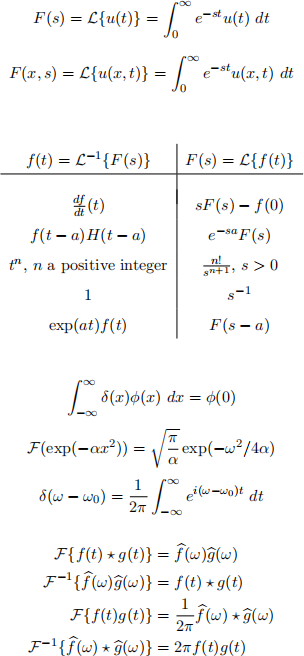MATHS 361 Partial Differential Equations FIRST SEMESTER, 2019
Hello, dear friend, you can consult us at any time if you have any questions, add WeChat: daixieit
MATHS 361
FIRST SEMESTER, 2019
MATHEMATICS
Partial Differential Equations
The formulas below may be used without proving them.

1. (a) (Total marks 18) The Fourier series of a function f (t) defined on the interval [-π, π] can be written as
a2 + ![]() a ncos(nx) +
a ncos(nx) + ![]() bn sin(nx)
bn sin(nx)
where
a2 = ![]() mm f (x) dx, an =
mm f (x) dx, an = ![]() mm f (x) cos(nx) dx, bn =
mm f (x) cos(nx) dx, bn = ![]() mm f (x) sin(nx) dx
mm f (x) sin(nx) dx
Let δ(x) denote the dirac delta function. Find the Fourier series of δ(x) in the distributional sense. (6 marks)
(b) Let H be defined as
H(x) = { 1(0) 0(x) ![]() x(0),
x(0),
Use the definition
< f} , φ >= - < f, φ} >
to find the distributional derivative of H(-t). (6 marks)
(c) Show that
δ(x2 - a2 ) = ![]() [δ(x + a) + δ(x - a)]
[δ(x + a) + δ(x - a)]
![]() [Hint: Use the substitutions x = ′u and x = -′u
[Hint: Use the substitutions x = ′u and x = -′u![]() .] (6 marks)
.] (6 marks)
2. (Total marks 16) This question is about finding the solution u(x, t) to the following problem using Laplace Transforms.
ut = c2uzz , 0 < x < o , t > 0,
u(x, 0) = T2 , 0 < x < o ,
u(0, t) = 0, 0 < t < o ,
u(x, t) → 0, as x → o .
(a) Let F (x, s) be defined as
F (x, s) = c{u(x, t)} = l2 & e –stu(x, t) dt
Use Laplace Transforms to write down a differential equation for F (x, s). (6 marks) (b) Hence find the solution u(x, t) that satisfies the initial and boundary conditions given above.
You may assume the result that
![]() c– 1
c– 1 ![]() = 1 - erf
= 1 - erf ![]() )
)
where erf is the error function. (10 marks)
3. (Total marks 14) The Fourier transform r(f) of the function f (x) is defined as
r{f } = l&& f (x)e –iuz dx
Use Fourier Transforms to find the general solution to the transport equation
![]() + c
+ c![]() = 0, -o < x < o , t > 0, u(x, 0) = g(x).
= 0, -o < x < o , t > 0, u(x, 0) = g(x).
You may use the result that the Fourier transform of g(x - a) is exp(-iaω)G(ω) where G(ω) is the Fourier transform of g(x).
4. (Total marks 18) Consider the boundary value problem
dx(d2)![]() = x2 , u(0) = 1, u(1) = 2.
= x2 , u(0) = 1, u(1) = 2.
(a) Let G(x, s) be the Green’s function for this problem. Write down
(i) the differential equation satisfied by G(x, s),
(ii) the boundary conditions satisfied by G(x, s), and
(iii) the continuity condition G(x, s) must satisfy. (6 marks)
(b) Find G(x, s). (8 marks)
(c) Use G(x, s) to calculate u(x). (4 marks)
5. (Total marks 29) Consider the following problem which involves the steady state temperature of a square plate 0 < x < 1, 0 < y < 1:
u zz + uyy = 0, 0 < x < 1, 0 < y < 1,
u(0, y) = 0, u(1, y) = 0, 0 < y < 1,
u(x, 0) = 0, u(x, 1) = g(x), 0 < x < 1,
where g is some unspecified function.
(a) Find all functions u of the form u(x, y) = X(x)Y (y) that are solutions to the PDE and the homogeneous boundary conditions. (12 marks)
(b) Find the solution of the PDE for the case g(x) = 1. You may leave the eigenfunction expansion coefficients in inner product form. (5 marks)
(c) Solve the problem
v zz + vyy = 0, 0 < x < 1, 0 < y < 1,
v(0, y) = 0, v(1, y) = 1, 0 < y < 1,
v(x, 0) = 0, v(x, 1) = 1, 0 < x < 1.
Hint: make appropriate use of your solution to (a) and (b). You may leave the eigenfunction expansion coefficients in inner product form. (12 marks)
2023-06-12